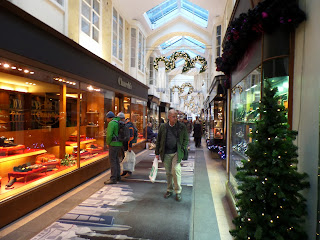On Monday we visted the Australia Exhibition at the Royal Academy of Arts, London. A remarkable collection of Australian art, drawn from many art galleries in Australia. Although it was only a relatively small selection of Australian art, it was special in that it presented more than 200 years of art. The core theme was the uniqueness of land and landscape and indigenous and colonial history.
The exhibition certainly portrayed the importance of the quality of light and the harshness of the landscape and the indigenious peoples' relationship with the land, in that it is an extension of the body, the heart, mind and soul, plus spiritual being. There was a substantial amount of indigenous art, displayed in the exhibition.
Initially artists followed European tradition in their approach to painting in Australia, but then recognised the distinctive qualities and diversity of the Australian landscale, its geology, flora and fauna. They then started painting in a style that was authentic in conveying its Australianness.
Sydney Nolan's portrayal of the outlaw, Ned Kelly, painted in 1946. This was photograph was taken of the front of the substantial catalogue, which we purchased at a much lower cost, due to the exhibition finishing soon.
We set off from St Mary Cray Railway Station, on the train bound for Victoria Railway Station, and then it was one tube stop on the Victoria line, to Green Park. Very easy, although we had to wait for half an hour on the train at St Mary Cray. Luckily there was a heated waiting room.
The Royal Academy of Arts. Quite a magnificent building.
And inside the building it was very grand, and elegant. This was my final photograph before entering the exhibition. No photographs allowed inside the exhibition rooms.We had lunch, sandwiches and coffee from the cafe, in the elegant and comfortable lounge area outside the restaurant. I loved the art deco lamp, with the elegant wrought iron balustrade behind it.
After we left, we walked through the glitzy Burlington Arcade, which was next door to the Academy. Walter admiring the expensive items for sale in the shops, and wondering if he has enough money to purchase a new pair of shoes. No prices shown of course.
The carpet in the arcade had scenes from cities around the world woven into it. Fascinating. The scene for Australia - Sydney's Opera House. Outside in the street, there were more ornate buildings. This was the London Ritz Hotel.
And the doorway into the Ritz.
Now I am not sure what this statue represents, but it was a very large and grand statue on top of one of the buildings. Almost rivals the statues in Paris.
Home again, and out came our placemats. We have two sets of placemats, showing indigenous paintings, still in good order, although they are thirteen years old. Over the years they have been used as examples for children, when studying Aboriginal art in school.
We have had this set of placemats for about thirty years, each one depicting a scene from early Australia. This placemat is in pristine condition, due to it not being used much. 'The Settlers' by Frederick McCubbin (1904) depicts the struggle for early settlers, and in the third scene, the wife has died. The town in the background of this scene is meant to symbolise hope for the future. I always found this painting a little depressing when eating dinner so avoided using it. The original painting was on display at the Australia exhibition.
I found the exhibition fascinating, and certainly learnt so much about the development of art in Australia. And I must admit the short walk along Piccadilly, was also fascinating. A little piece of expensive London.




No comments:
Post a Comment